|
CNH
4wd Tractor Heritage
46 Years of 4 Wheel
Drive Power
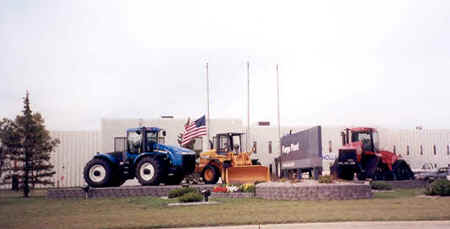 |
CNH represents a family of brands that have shaped the
history of agricultural equipment. The CNH heritage includes the combined
legacies of J.I. Case, Fiat, Ford, International Harvester, New Holland,
Steiger and many others. In May 1999 Fiat purchased 70% of Case Corp's
stock to bring the company into partnership with its New Holland Agricultural
line. In November 1999 CNH Global was formed. With so many strong brands
combined under the Case-New Holland umbrella the tradition of innovation runs
deep throughout the roots of the company. Over the course of the last 170 years
CNH's brands have lead the way in creating the future of agricultural
mechanization. Cyrus McCormick's reaper invented in 1830 started CNH's
legacy. This reaper would serve as the impetus for the McCormick
Harvesting Machine Company, formed in 1848. This company, which led to the
creation of International Harvester in 1902, would go on to pioneer the first
dealer distribution channel, the first full-line product offering implements,
tractors, harvesting, hay, the first diesel wheel tractor in the U.S., and the
first axial flow combine. International Harvesterís signature product, the
famous Farmall tractor, was a pioneer for row-crop tractors. Jerome Increase
Case was also making his mark on agriculture in the mid-1800ís. In 1842, Case
founded his "Racine Threshing Machine Works" on the strength of his
innovative thresher. By the 1970's J.I. Case was know world wide for high horse
power tractors and construction equipment. Abe Zimmerman started New Holland
Machine in 1895 and by the 1950's New Holland was the industry leader in
grassland farming. Henry Ford was a farmer at heart and in 1917 he created
Henry Ford and Son to produce inexpensive hard working tractors. During the
1920ís, 75 percent of U.S. farms used a Fordson tractor. By 1966, Ford
Tractors were number two in sales worldwide. Douglas and Maurice Steiger who
wanted a bigger tractor in the late 1950's decided to build one. With the
"solve your own problems" attitude the built the brand that has been
best known for over 30 years as the 4wd tractor industry leader. In 1990
Fiat a long time European tractor maker acquired Ford-New Holland to form New
Holland. The spirit of innovation has been a driving force behind the
growth of CNH's companies over the years, and is one of the common elements that
has unified them today. Today CNH is combing the success and strength of
brands on common platforms.
CNH's 4wd history spans 46 years with names like
Steiger, International Harvester, Case and New Holland. It all
started with the #1 name in 4wds: Steiger. In 1958 the Steiger Brothers
built a tough and big articulated tractor from common components found on big
semi-trucks. The commonality of Steiger parts allowed the 4wd brand to grow
across North America. By the 1970's Steiger built a a range of 4wds from 225 hp
to 320 hp in a massive factory in Fargo, North Dakota. The 1970's was the golden
era of Steiger. Steiger was best known for 4wds with cat names.
Models like the Puma, Wildcat and Bearcat served smaller operations well and as
a second 4wd. Names like Cougar, Panther, Lion and Tiger meant big power for big
spreads. Steiger became the #1 brand in 4wds and in 1986 it became part of
Case-International. in 1995 CaseIH returned to name Steiger to its 4wds
and Steiger still leads the way in articulated high horse power.
Just a few years after the Steiger 4wd was built
International Harvester the number one name in the tractor industry with the
Farmall introduced a 4wd. IH's Hough Industrial division developed a massive
articulated 4wd known as the 4300. The 4300 was a big articulated tractor
a little far ahead of it time in the 60's. The 4300 was just too big for
the majority of the farmers of the day so in 1966 IH introduced the ridged frame
4100 which offered two wheel or four wheel steering. The 4100 was ultra modern
for its day and the design remained in the IH 4wd line through 1978 when it was
replaced by the 2+2. In 1973 IH teamed up with Steiger to build an
articulated 4wd. The original articulated IH 4wd by Steiger was the 4366. The
4366 used the Steiger cab and body and was powered by an IH engine and the rear
end shared components from the IH 1466. The Steiger/IH 4wds were a popular line
and were part of the IH line for 9 years. In 1979 IH made it biggest mark
in the 4wd industry with the 2+2. The 2+2 best known as the Anteater or
Snoopy provides 4 wheel drive with 2wd ease. The operator sits behind the
articulation back where they can see the field work and implement. 25 years
after the 2+2's introduction these long nose tractors remain popular in many
areas. In 1984 International became part of Case and the IH red color
became the standard color of the new company. In 1985 Case ridged frame tractors
and in 1986 Steiger tractors bore the name Case International and the Harvester
red color.
Case entered the 4wd market in 1964 with a rigid frame
tractor. Case's 4 way steer tractors made a mark in the 4wd industry for 30
years. In 1969 Case launched its Traction-King the TK1470. This
tractor offered power, a cab and 4 way steer. In 1972 the second generation
Traction King was introduced featuring a family styling with the 2wd Agri-Kings.
In 1985 when Case joined forces with International Harvester the ridged frame
all steer 4wds won out over the IH Super 70 4wds using the unique 2+2
design. Case International offered the Case Traction King 4wd through
1989. In 1990 Case International introduced the new 9200 series 4wd. The
Traction King ridged frame was married to a Steiger cab and body. The ridged
frame 9240 and 9260 joined the Case International articulated 9200 4wds.
In 1995 CaseIH introduced the 9300 series and returned the Steiger name plate to
the line. The 4 way steer Case design was retired. The Row-Crop Special
9330 and 9350 with a steer able front axle and articulated rear end carried on
the Case tradition through 2000. In 2000 CaseIH introduced the STX
Steigers with the smaller STX 275 and 325 Steigers offering a front and rear
articulation, called Accusteer, for tight turning.
New Holland is the 4th big name in the CNH 4wd heritage.
In 1978 Ford released its FW series 4wds built by Steiger. The Ford FW were the
first big blue 4wds and offered a range of horse power from 210 hp to 360 hp in
four models. Ford offered Steiger built FW 4wds through 1982 in North America
and through 1987 in Europe In 1987 the new Ford-New Holland company
purchased Versatile 4wd Company. Versatile is a well known name in 4wds and a
strong tractor. In 1990 Fait purchased Ford-New Holland from Ford
Motors. The new company became New Holland and in 1994 the Versatile 4wd
was redesigned and the 80, 82, and 84 series New Holland-Versatile 4wds made New
Holland a strong name in the 4wd market.
On May 15, 1999 Fait purchased Case Corp. and new company
became Case-New Holland. CNH has brought the heritage of Steiger,
International Harvester, Case and New Holland together with two lines off 4wds
built at the Steiger plant in Fargo, North Dakota. CaseIH's red STX
Steigers are number one in the industry with both tire and 4 track models
ranging from 275 hp to 500 hp. New Holland's TJ 4wds share a common
platform with the STX 4wds but unmatched mega flow hydraulics. Both the
STX and TJ 4wds from CNH are power and performance leaders in the tractor
industry.
Below is the 46 year time line
of CNH's 4wd heritage. It is interesting to see how Steiger, International
Harvester, Case, Ford, New Holland and Fiat crossed paths over the past 4
decades and ultimately combined forces to create the worlds largest tractor
company.
|
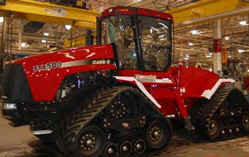
|
In
2003 Case IH added a 500 hp unit to its Steiger line of tractors. The Case IH STX500 Steiger
comes in wheeled and Quadtrac versions. It features a new turbulated
tube radiator to increase engine cooling capacity. A lengthened air
filter delivers the air needed for the increased power. The
extended wheel base and position of the center pull drawbar transfer
engine horsepower into pulling power. It
provides up to 39 percent torque rise and up to 50 horsepower growth to
conquer hills and mud spots without downshifting. The extra large cab
features almost 68 sq. feet of tinted glass |
|
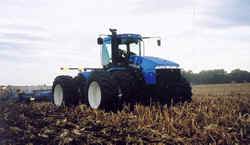
|
|
New Holland TJ 4wds unprecedented
engine and hydraulic power to handle your heaviest loads and
harshest conditions with ease. You'll also experience a new
dimension of comfort, efficiency and convenience. TJ's shine with
the highest hydraulic flow in the industry which helps operate
implements efficiently. A 40-gpm pump is standard on most models
(42 gpm on the TJ500), with 55 gpm standard on the TJ375, TJ425
and TJ450 scraper models. And, now farmers can put the new
TJ500órated at an impressive 500 horsepower and featuring an
incredible power growth of 50 hp.
|
|
|
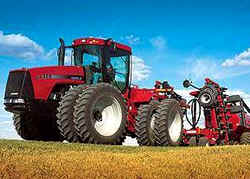
|
The STX Steigers are new 4wds from the
ground up. CaseIH identified 100 specific items that farmers wanted
improved in a 4wd. With in the STX lineup are 13 new models. The four
base models include the STX 440, STX 375, STX 340, and STX 325.(The
model number designates engine horsepower). The options include Quadtrac
models, AccuSteer models for row crop work and
Industrial models. The new STX represents the best of the more than 40
years the Steiger name has been used on big tractors. |
|
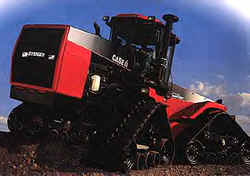
|
In
1996 CaseIH introduced the first 4 tracked tractor. The use of tracked
equipment for field work is not new but what was new is the popularity
of rubber tracked tractors.
The advantage of using a tracked vehicle is that by reducing the amount of compaction and
still allowing the tractor to pull massive implements there is a
tangible improvement in productivity. The Quad Trac's swiveling chassis
produced even less disturbance than the Cat or John Deere which,
though using rubber tracks still has to use braking to turn and throws
up some dirt as it does so. Ouad-Trac 4wds have dominated both the
Ag and industrial scraper market since their introduction |
|
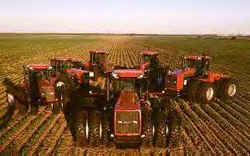
|
The
9 workhorses of Case IH's 9300 Series brought power, performance and
flexibility to four-wheel drive line in 1995. By 1996 with the
introduction of the 9390 the models range from 240 to 425
horsepower, with two Row Crop Special models. STEIGER 4WD tractors have
a performance record and a proud lineage that spans several decades and
the name was brought back on the 9300 series.
Like their predecessors, the 9300 Series tractors were designed and
manufactured in Fargo, North Dakota. |
|
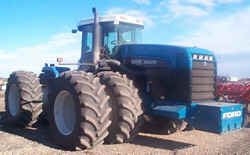
|
New
Holland introduced its new range of Versatile 4wds in 1993 upgrading the
design, power and cab. They featured Cummins
diesel engines with Constant Power to provide a steady drawbar pull in
changing field conditions. Their Quadra-Sync 12x4 transmission featured
three ranges, with four synchronized sequential shifts in each range.
Hi-Flo hydraulics with high flow at the remotes. The New Holland
4wd line ranged from 260 hp to 425 hp over three series including the
80, 82 and 84 series. In 2000 New Holland sold the Versatile 4wd
line to Buhler under monopoly regulations during the CNH merger. |
|
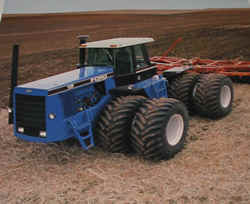
|
Ford-New
Holland purchased the well known Versatile line in 1987.
Through the late 1980's Versatiles remained yellow, red and black with a
Ford oval in the hood. In 1990 Ford began painting the Versatiles in
Ford blue and white. The range of Ford 4wds were offered from 230 hp to
470 hp. The big 470 hp 1156 was sold in Ford colors only in 1990
as remaining models were sold out. |
|

|
In
1986 Tenneco purchased the Steiger brand. Steigers from the 168 hp
Puma 1000 to the 525 hp Tiger KP-525 were painted Case International red
and renamed the 9100 series. The Puma became a 9110, the Wildcat became
a 9130, the Cougar became a 9150, the Panther became a 9170, the Lion
became a 9180 and the Tiger a 9190. The 9100 series were offered as
Case Internationals and Steigers through 1989. The 9200 series
4wds were
only offered as Case International models. |
|

|
In
November 1984 International Harvester sold its Ag division to Tenneco
the owner of J.I. Case. In
1985 the new Case International released its new line. The Case 94 series
4wds were chosen for the new brands top models over the IH Super 70
4wds. Case International's 4wds included models introduced in 1984
ranging 174 hp up to 400 hp with the all new 4994. |
|
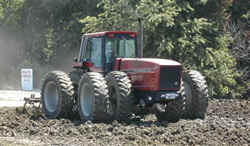
|
In
1979 International Harvester introduced the 2+2 tractor. The 2+2 gave
a farmer 4wd traction and 2wd maneuverability. This particular
model is called a 2+2 because it consists of one two wheel drive tractor
mated with another. To take advantage of the 86 series "Command
Cab" and final drive, International designed the 2+2 so the solid
front axle steered by pivoting the front half front half of the tractor. The long hood housed
the engine-before-drive-axle configuration, requiring no engine
redesign. Because of this tractors long hood it is often called an
"Anteater" or "Snoopy." In 1985 IH introduced the Super 70 7288 and 7488. These tractors
replaced the Generation II 6388, 6588 and 6788 2+2. The Super 70's
were marketed by IH as 4wds and not 2+2's. |
|
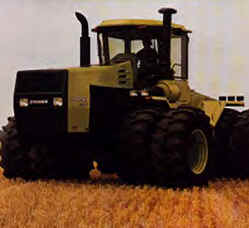
|
In
1983 Steiger made a huge jump forward over its competition with new
sleek and powerful 1000 series 4wds. The 1000 series design was so
far ahead of its time that CaseIH used the same body styling through
2000. The 1000 series range included the row crop 168 hp Puma 1000
up to the 400 hp Panther CP-1400. |
|
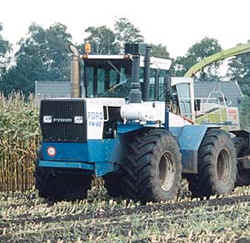
|
From
1978-1982 Steiger provided Ford with a line of 4wds from 210-360 hp.
These Blue Steigers were sold as the 210 hp Ford FW-20, 270 hp FW-30,
295 hp FW-40 and the 360 hp FW-60. The FW's were based on the
Steiger PTA Cougar and Panther III 4wds. The Ford 4wds were
offered in Europe through 1987. The latter European FW's were
based on the Steiger series IV tractors. |
|
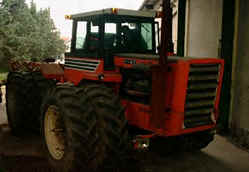
|
Fiat
the parent company of Case-New Holland has been a long time tractor
maker. Fiat tractors are well known in Europe and Africa. In the
1970's Fiat acquired the Hesston Corporation of Hesston, KS.
Hesston was well known for its hay and manure handling equipment.
Fiat began selling its well known tractors as Hesston in north America
after the purchase. In 1979 Fiat started looking at the 4wd market
and larger horse power. The company turned to Versatile to produce
a range of 230 hp - 350 hp 4wds. The Fiat 4wds were Versatiles
painted in Fiat Terracotta red. The Fiat 44 series 4wds were offered
from 1979-1982. |
|
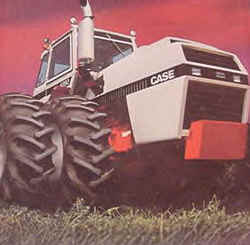
|
Case
added new power and comfort to its 4wd in 1979 with the 4490, 4690 and
4890 4wds. These 4wds shared the same styling as the 2wd 90 series
tractors. The Silent Guardian cab added a new lever of quite comfort for
hours of field work. The smaller 4490 and 4690 tractors were built
for row crop work like corn cultivating and forage harvesting. The
big 4890 had the power to match articulated 4wds with a big turbo power
Saab engine. |
|
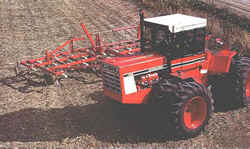
|
In
1973 International teamed up with Steiger to build articulated 4wds. The
IH 4wds used Steiger engineering and IH design and styling. The
first model was the 4366. A V-8 powered 4568 was added in 1976 and
followed by the 86 series in 1977. The 86 series included
the 6 cylinder 4586 and V-8 powered 4586 and 4786. In 1982
prototype 7388, 7588 and 7788 tractors were built to replace the 86
series but IH decided to go with its new 2+2 design. |
|
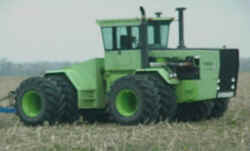
|
Steiger
continued to lead the 4wd market into the late 1970's. In 1976 the
series III Steigers were introduced with new power and comfort. In
1979 Steiger toped off the series III line with the big 450 hp ST-450
Tiger and 470 hp ST-470 Tiger. The Tiger Steigers were built for big
tillage. These tractors could pull plows up to 16 bottoms. |
|
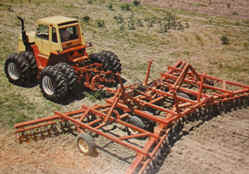
|
When
Case first introduced the 1200
4wd tractor in 1964, the concept was not an immediate success. It was
not until 1972 when four-wheel-drive power became the fastest growing
segment of the North America tractor market. J.I. Case was there to meet
the demand with the new 174 hp model 2470 4wd which incorporated the cab
and platform as an integral unit with 70 series styling. The
2470 was joined by the 2670 and 2870. In 1975 Case tractors changed from
Desert Sunset Tan to Power White. |
|
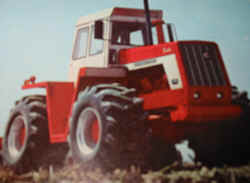
|
The
International Harvester 4166 was released in 1971. It was painted
harvester red to match the rest of the new 66 series tractors. IHC's
Original Frank G. Hough derived Model 4100 and later 4156 four-wheel
drive tractors were painted yellow. The 150 hp International 4166
four-wheel drive and four-wheel steer tractor was a proven workhorse for
high speed, hard-pull tillage. When not under a load 2/3 of the tractors
weight is over the front wheels; but under a load, weight transfers to
the rear wheels to boost traction and pull. The 4166's insulated cab
offered a heater and air conditioner along with a positive air pressure
ventilation system to keep dust out. In 1977 the 4166 was replaced by
the 4186,
which was the last 4 wheel steer model offered by IH. |
|
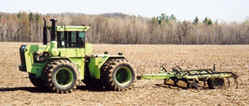
|
By
1970 Steiger 4wds were built in a large factory in Fargo, North Dakota.
This factory is the home of CNH 4wd production today. In the
1970's Steiger 4wds had new family styling and a jungle cat theme with
names like Wildcat, Bearcat, Cougar, Panther and Tiger. The cabs even
shared the theme with the Safari name. |
|
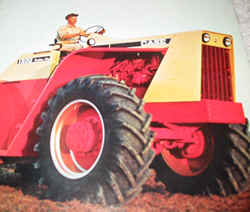
|
Introduced
in 1964, the 1200 Traction King was the first 4wd from Case.
It was the first large 4wd in the Ag industry to offer coordinated
steering. The 1200 filled Case's need to bring a high horse power
tractor to market to compete against John Deere's 121 hp 5010,
International Harvesters 214 hp 4300, and
Minneapolis-Moline's 101 hp G 706. The turbocharged Lanova
451-cubic inch engine that powered the 1200 was rated at 119 hp. Rather
than beefing up the Comfort-King line with more weights and components a
coordinated steer model was developed to bring high horse power to the
ground efficiently. The 1200's open station platform allowed to
operator to enter or leave the operator's station with ease.
|
|
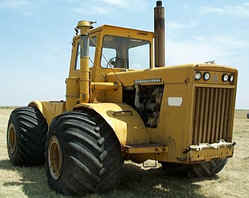
|
In
1961 IH entered the 4wd market with the model 203 hp 4300. At that time
this tractor was seen as too large for most farms of the time.
Only 44 models were built during the 4300's production run from
1961-1965. It was the beginning of the IH 4wd line that would run for 20
years and gain a 28% market share at its height in the 1970's. The
4300 came with air brakes, rear hydraulic lifting drawbar and was
available with an optional cab. |
|
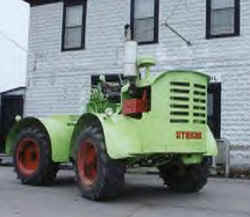
|
Douglas
and Maurice Steiger who wanted a bigger tractor in the late 1950's
decided to build one. In 1958, With the "solve your own
problems" attitude the brothers rounded up a bunch of truck parts,
a 238 hp Detroit diesel engine and built the first Steiger tractor 1 FWD
in their farm shop located in Red Lake Falls, Minnesota. The first
Steiger tractors sold on a national scale in 1963 were the 1200, 1700,
2200 and 3300 Steigers. Steiger tractors were successful because
their main feature was " standard components." Major parts,
such as engines, transmissions and power trains were outsourced from
brand name suppliers like Caterpillar, Cummins, Allison, Clark and
Spicer. |
|
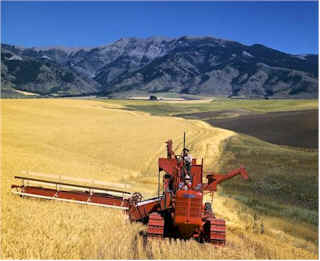
|
CNH's
leadership in big agricultural tractors reaches back to the
1940's. International Harvester in 1939 released a line of TD
crawlers. Before big horse power could be put to the ground with 4
tires, IH used steel tracks on crawler tractors. By 1947 the large
TD-24 IH crawler was putting out 162 horse power. This allowed
farmers to pull as much as 21,873 pounds. In comparison IH's
biggest Farmall of the day was 50 hp. |
|
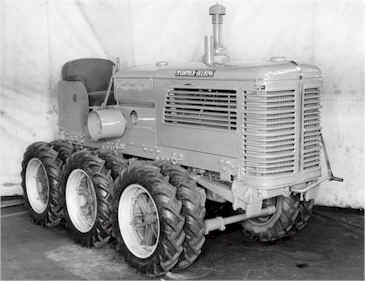
|
CNH's
earliest multi-traction design dates back to December 1,1937 with the
International Harvester's McCormick-Deering 6wd tractor. This
design never made it past the experimental phase. During the
1940's IH focused on large crawler tractors rather than large horse
power models with pneumatic tires. Additional historical pictures
like the 6wd IH can be found at www.wisconsinhistory.org. |
Photographs from CaseIH, New Holland,
Steiger, International Harvester, J.I. Case Sales Literature for Identification
Purposes, from Jason Hasert and John Schomberg. These pictures may not be copied
from Big Tractor Power.com

|